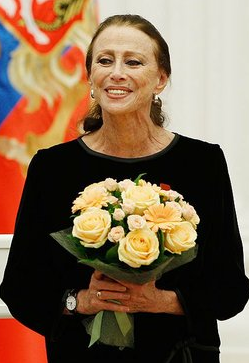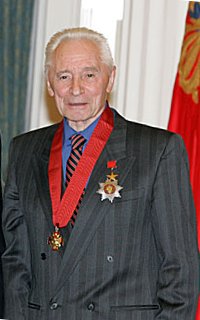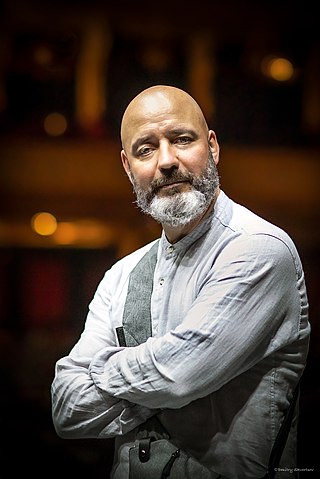
Sumio Iijima is a Japanese physicist and inventor, often cited as the inventor of carbon nanotubes. Although carbon nanotubes had been observed prior to his "invention", Iijima's 1991 paper generated unprecedented interest in the carbon nanostructures and has since fueled intense research in the area of nanotechnology.

Maya Mikhailovna Plisetskaya was a Soviet and Russian ballet dancer, choreographer, ballet director, and actress. In post-Soviet times, she held both Lithuanian and Spanish citizenship. She danced during the Soviet era at the Bolshoi Theatre under the directorships of Leonid Lavrovsky, then of Yury Grigorovich; later she moved into direct confrontation with him. In 1960, when famed Russian ballerina Galina Ulanova retired, Plisetskaya became prima ballerina assoluta of the company.

Yury Nikolayevich Grigorovich is a Soviet and Russian dancer and choreographer who dominated the Russian ballet for 30 years.

Irina Konstantinovna Arkhipova was a Soviet and Russian mezzo-soprano, and later contralto, opera singer. She sang leading roles first in Russia at the Sverdlovsk Opera and the Bolshoi Theatre, and then throughout Europe and in the United States. People's Artist of the USSR (1966) and Hero of Socialist Labour (1984).
Cristina Hoyos Panadero is a Spanish flamenco dancer, choreographer and actress, born in Seville, Spain. After a successful worldwide career, she opened her own dance company in 1988 that premiered at the Rex Theatre in Paris. She played an important role during the opening and closing ceremonies of the 1992 Summer Olympics in Barcelona.

Víctor Ullate is a dancer, choreographer, ballet director and ballet teacher.
Vladimir Mikhailovich Zakharov was a Russian choreographer, founder, Chief Choreographer and Artistic Director of Moscow National Academic Theater of Dance Gzhel and Moscow Ballet Academy Gzhel, Ph.D. in Study of Culture, Academician, Director of the University of Dance under the Academy of Slavic Culture, People's Artist of the Russian Federation, Honoured Artist of Dagestan Republic, People's Artist of The North Ossetia-Alaniya Republic.
Ji-young Kim is a South Korean prima ballerina and is currently a principal dancer with the Korea National Ballet (KNB) in Seoul, South Korea.
The Korea National Ballet is a South Korean ballet company. It was founded in 1962 in Seoul as the National Ballet Company. It was one of the affiliates of the National Theater of Korea until 1999, when it separated to independently reestablish itself in the Seoul Arts Center in the following year.
The ballet Prince Hodong, sponsored by the Ministry of Culture, Sports, and Tourism as a part of the Nation Branding project, is an original work based on a traditional tale, Prince Hodong and Nakrang Princess. Sung-nam Lim, the 1st Artistic Director of the Korea National Ballet, choreographed Prince Hodong in 1988 and Byung-nam Moon, the Deputy Artistic Director, newly interpreted it as a 21st-century ballet. Although there have been many dances created based on Korean literature over the last 50 years of the Korea National Ballet, the ballet Prince Hodong is itself a great piece of art because the tale Prince Hodong consists of a dramatic plot. Prince Hodong is based on our cultural text and with the themes - the nations, war, love, betrayal, and death - this work is composed of 2 acts and 12 scenes which combine modern techniques and classical sentiment. Prince Hodong is a ballet which presents an example of the globalization of Korean culture in the 21st century by combining western artistic culture with Korean traditional culture.
Young-jae Jung is a South Korean ballet dancer. He is currently a member of the Korea National Ballet where he is a soloist.

Lorenzo Harris is a dancer, choreographer, artistic director and professor of hip-hop dance. Harris formed the first and longest running hip-hop dance touring company, Rennie Harris Puremovement in 1992. In 2007, he conceived another touring company, RHAW or Rennie Harris Awe-Inspiring Works.

Vadym Pysarev is a famous Ukrainian dancer, People's Artist of Ukraine, Art Director of Donetsk State Academic Opera and Ballet Theatre named after A. Solovyanenko, founder and director of international festival World Ballet Stars.
Elam Endira Devi, is an Indian classical dancer and teacher, known for her expertise and scholarship in the classical dance form of Manipuri, especially in the genres of Lai Haraoba and Raas. The Government of India honored her, in 2014, with the Padma Shri, the fourth highest civilian award, for her services to the field of art and culture.

Valentin Nikolayevich Elizariev is a Belarusian Soviet balletmaster, choreographer, and pedagogue. He was awarded the title of People's Artist of the USSR in 1985.
Pál Frenák is a Hungarian dancer, director and choreographer. His aesthetic is influenced by sign language, architecture, cinema, Butoh, and by the work of French philosopher, Gilles Deleuze. His company was founded at the height of European Post-Dramatic Theater, and came to the fore during Hungary’s transition from communism.

Radu Poklitaru – choreographer-director working in Ukraine and many other countries of the world, the Honoured Worker of Culture of Ukraine (2017), the Shevchenko National Prize of Ukraine winner (2016), The Personality of the Year prize winner (2017), the People's Artist of Moldova (2016), the laureate of numerous international contests, the founder and the chief ballet master of the Kyiv Modern-Ballet Academic Theatre. Professor of the Department of Modern Choreography at the Kyiv National University of Culture and Arts.

Krzysztof Pastor is a Polish dancer, choreographer and ballet director. He was resident choreographer with the Dutch National Ballet in Amsterdam from 2003 to 2017, director of the Polish National Ballet in Teatr Wielki – Polish National Opera in Warsaw since 2009 and at the same time from 2011 until 2020 was the artistic director of the ballet of the Lithuanian National Opera and Ballet Theatre in Vilnius.

Joseph Victor Gonzales is a Malaysian choreographer, who is professionally known as Joseph Gonzales. Currently, he is a recognized expert in the choreography and interpretation of traditional dances in Malaysia, prominent in the theater and in the field of dance pedagogy. He is widely regarded as one of the leading voices in Asia and specifically Southeast Asia. In 2011, he established the ASK Dance Company, a private, professional dance company in Malaysia with the aspiration to provide a space for greater professionalism in dance. Through this company, he works to revitalize and revive traditional dances of Malaysia via Forging Traditions, as well as produce both traditional performances and innovative contemporary dance productions.

Evgeniy Svetlitsa is a Ukrainian ballet dancer, and former soloist at Lviv Theatre of Opera and Ballet from 2000 until 2022. Merited Artist of Ukraine since 2015. Winner of the Vadim Pisarev Prize.











